Tel Hazor
Tel Hazor (Hebrew: תל חצור), also Chatsôr (Hebrew: חָצוֹר), translated in LXX as Hasōr (Ancient Greek: Άσώρ)[1][2] and Tell el-Qedah (Arabic: تل القدح), is an archaeological tell at the site of ancient Hazor, located in Israel, Upper Galilee, north of the Sea of Galilee, in the northern Korazim Plateau. In the Middle Bronze Age (around 1750 BC) and the Israelite period (ninth century BC), Hazor was the largest fortified city in the country and one of the most important in the Fertile Crescent. It maintained commercial ties with Babylon and Syria, and imported large quantities of tin for the bronze industry. In the Book of Joshua, Hazor is described as “the head of all those kingdoms” (Josh. 11:10).
תל חצור | |
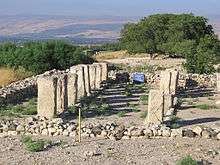 House of Pillars at Hazor | |
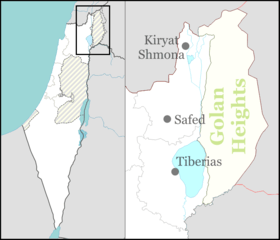 Shown within Northeast Israel  Tel Hazor (Israel) | |
| Location | Tell el-Qedah, Israel |
|---|---|
| Region | Upper Galilee |
| Coordinates | 33°1′0″N 35°34′1″E |
| Type | Settlement |
| History | |
| Abandoned | 732 BC |
| Official name | Biblical Tells – Megiddo, Hazor, Beer Sheba |
| Type | Cultural |
| Criteria | ii, iii, iv, vi |
| Designated | 2005 (29th session) |
| Reference no. | 1108 |
| State Party | Israel |
| Region | Asia-Pacific |
The Hazor expedition headed by Yigal Yadin in the mid-1950s was the most important dig undertaken by Israel in its early years of statehood. Tel Hazor is the largest archaeological site in northern Israel, featuring an upper tell of 30 acres and a lower city of more than 175 acres.[3]
In 2005, the remains of Hazor were designated a World Heritage Site by UNESCO as part of the Biblical Tels - Megiddo, Hazor, Beer Sheba.
Excavations
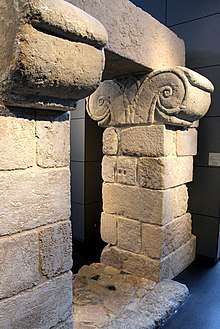
The site of Hazor is around 200 acres (0.81 km2) in area, with an upper city making up about 1/8 of that. The upper mound has a height of about 40 meters. Initial soundings were carried out by John Garstang in 1926.[4]
Major excavations were conducted for four seasons from 1955 to 1958 by a Hebrew University team led by Yigael Yadin.[5][6][7][8] Yadin returned to Hazor for a final season of excavation in 1968.[9] The excavations were supported by James A. de Rothschild, and were published in a dedicated five volume set of books by the Israel Exploration Society.
Excavation at the site by Hebrew University, joined by the Complutense University of Madrid, resumed in 1990 under Amnon Ben-Tor.
Findings from the dig are housed in a museum at Kibbutz Ayelet HaShahar. In 2008, some artifacts in the museum were damaged in an earthquake.[10]
In 2010, a clay tablet was discovered dating from the 18th or 17th centuries BC inscribed with laws in the style of Hammurabi's Code. The document includes laws pertaining to body parts and damages, similar to laws such as "an eye for an eye" that appear in the Book of Exodus. The document is written in Akkadian cuneiform, the diplomatic language of the period.[11]
There had been claims by Christian polemicists that an artifact found at Hazor is that of "Allah, the moon god".[12][13]
Chronology
This table lists the strata, or layers of ruined settlements that accumulated to form Tel Hazor according to Hazor archeologist Sharon Zuckerman. The shades represent the different archeological periods: Bronze Age, Iron Age, Persian period and Hellenistic period. Some layers are associated with the content of contemporary historical sources.[14]
| Fixed date (BCE) | Archeological Period | Stratum (Layer) - Upper City | Stratum (Layer) - Lower City | Excavation results | Historical references |
|---|---|---|---|---|---|
| 28th century | Early Bronze Age III-II | XXI | Houses | ||
| 27th century 24th century | Early Bronze Age III | XX-XIX | Houses and a monumental structure (possibly a palace or other central building) | ||
| 22nd century 21st century | Middle Bronze Age I/Intermediate Bronze Age | XVIII | Houses | ||
| 18th century | Middle Bronze Age IIA-B | Pre XVII | Burials and structures | Egyptian Execration Texts | |
| 18th century 17th century | Middle Bronze Age IIB | XVII | 4 | Erection of the earthen rampart of the Lower City | Mari archive |
| 17th century 16th century | Middle Bronze Age IIB | XVI | 3 | Both Upper and Lower Cities are settled. | |
| 15th century | Late Bronze Age I | XV | 2 | Both Upper and Lower Cities are settled. | Annals of Thutmose III |
| 14th century | Late Bronze Age II | XIV | 1a | Both Upper and Lower Cities are settled. | Amarna letters |
| 13th century | Late Bronze Age II | XIII | 1b | Both Upper and Lower Cities are settled. | Papyrus Anastasi I |
| 11th century | Iron Age I | XII-XI | pits and meager architecture | ||
| mid 10th century early 9th century | Iron Age IIA | X-IX | six-chambered gate, casemate wall, domestic structures | United Kingdom of Israel (possibly under Solomon) | |
| 9th century | Iron Age IIA-B | VIII-VII | casemate wall still used, administrative structures and domestic units | Northern Kingdom of Israel (Omri dynasty) | |
| 8th century | Iron Age IIC | VI-V | casemate wall still used, administrative structures and domestic units | Northern Kingdom of Israel (from under Jeroboam II to the Assyrian destruction by Tiglath-pileser III | |
| 8th century | Iron Age IIC | IV | sporadic settlement | post–Assyrian destruction; settlement (possibly Israelite) | |
| 7th century | Iron Age IIC (Assyrian) | III | governmental structures on and around the tell | ||
| 5th century 4th century | Persian | II | citadel, tombs | ||
| 3rd century 1st century | Hellenistic | I | citadel |
History
Early Bronze Age
The first settlement excavated in Tel Hazor is dated to the Early Bronze Age II and III periods, existing at around the 28th and 24th centuries BCE. It was part of a system of settlements around the Hula Valley, including Abel Beth Maachah, Dan and Kedesh. The settlement was exposed in limited areas where a few houses were discovered. Based on these finds, Early Bronze Age Hazor was not a significant settlement. With that said, it seems that a large monumental structure dated to the following Middle Bronze Age period was already erected in the Early Bronze Age, sometime after the 27th century BCE. If this is true it implies that already in its beginnings, Hazor was a well-planned settlement that served as an urban center. It also shows one of the earliest examples of Basalt slabs used as foundations to walls (Orthostates) in the Southern Levant, only preceded by a temple from Tel Megiddo. The transition to the Early Bronze Age III period is characterized by the movement of people from rural areas within the valley to major urban sites such as Hazor, Dan and Abel Beth Maachah. Thus the establishment of a possible palace in Hazor, as well as in Dan, attest to this phenomenon.[14]
Large part of Hazor's pottery from that time belongs to the Khirbet Kerak type. A petrographic study of these vessels has shown that they were made with local clays and that Hazor played a key role in distributing them across the country. The study also showed that other types of pottery were made of a different source of local clay. This use of two different local clays for two different families of vessels might indicate a technical decision or otherwise the presence of two or more workshops. One theory suggests that the manufacturers of the Khirbet Kerak tools, which were introduced to the settlement, chose or were forced to use a different source of clay, not controlled by the other workshops. Noteworthy is the discovery of 15 cylinder seal impressions on pottery from this period, added to another found some 2 kilometers south. This assemblage is one of the largest in the southern Levant and the fact it was found in such a small excavation area further supports the reconstruction of Hazor as an important city during this period.[14]
Intermediate Bronze Age
This period, at the end of the 3rd millennium BC, is a period of urban decline, separating the Early Bronze Age, which is the Levant's first urban era, from the re-urbanization of the region in the Middle Bronze Age. Throughout the country, most cities were abandoned and archaeologists found mainly small agricultural villages and tombs. Hazor, however, is one of the few exceptions. Remains of several structures from this period were discovered on the site reveal that Hazor was indeed settled in this period. A large amount of pottery belonging to the Megiddo Ware family was discovered in the site and forms the largest assemblage of this kind in the southern Levant. Also, a large amount of Copper ingots were collected. These two discoveries might shed light on pottery and metal industries that existed in Hazor during this period, proving its regional importance during this period of decline.[15]
Middle Bronze
During the Middle Bronze IIA (MBIIA; 1820-1550), Hazor was a vassal of Ishi-Addu of Qatna.
Execration Texts
In Egypt, Hazor is mentioned in the Execration texts.
Mari Archive
At Mari (Syria), on the Euphrates River, letters mention Hazor during the reigns of Yasmah-Adad and Zimri-Lim.[16] Hazor is part of a trade route Hazor-Qatna-Mari.
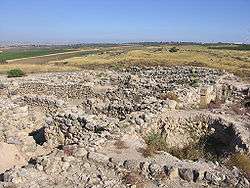
Late Bronze
| ḥwḏꜣr[1][2] in hieroglyphs |
|---|
During the Egyptian Second Intermediate Period and early New Kingdoms (together running between 18th century BC and 13th century BC), Canaan was an Egyptian vassal state; thus 14th century documents, from the El Amarna archive in Egypt, describe the king of Hazor (in Amarna letters called Hasura), Abdi-Tirshi, as swearing loyalty to the Egyptian pharaoh. However, EA 148 specifically reports that Hasura's king had gone over to the Habiru, who were attacking sites in Canaan. In these documents, Hazor is described as an important city in Canaan.
According to the Book of Joshua, Hazor was the seat of Jabin, a powerful Canaanite king who led a Canaanite confederation against Joshua, but was defeated by Joshua, who burnt Hazor to the ground.[17] According to the Book of Judges, Hazor was the seat of Jabin, the king of Canaan, whose commander, Sisera, led a Canaanite army against Barak, but was ultimately defeated.[18] Textual scholars believe that the prose account of Barak, which differs from the poetic account in the Song of Deborah, is a conflation of accounts of two separate events, one concerning Barak and Sisera like the poetic account, the other concerning Jabin's confederation and defeat.[19] In addition, the Book of Judges and Book of Joshua may be parallel accounts referring to the same events, rather than describing different time periods,[19][20] and thus they may refer to the same Jabin, a powerful king based in Hazor, whose Canaanite confederation was defeated by an Israelite army.[21]
Israel Finkelstein claims that the Israelites emerged as a subculture within Canaanite society and rejects the biblical account of the Israelite conquest of Canaan.[22] In this view, the Book of Joshua conflates several independent battles between disparate groups over the centuries, and artificially attributes them to a single leader, Joshua.[19] One archaeological stratum dating from around 1200 BC shows signs of catastrophic fire, and cuneiform tablets found at the site refer to monarchs named Ibni Addi, where Ibni may be the etymological origin of Yavin (Jabin).[22] The city also show signs of having been a magnificent Canaanite city prior to its destruction, with great temples and opulent palaces, split into an upper acropolis, and lower city; the town evidently had been a major Canaanite city. He theorized that the destruction of Hazor was the result of civil strife, attacks by the Sea Peoples, and/or a result of the general collapse of civilization across the whole eastern Mediterranean in the Late Bronze Age.[22]
Amnon Ben-Tor of the Hebrew University of Jerusalem believes that recently unearthed evidence of violent destruction by burning verifies the Biblical account.[23] In 2012, a team led Ben-Tor and Sharon Zuckerman discovered a scorched palace from the 13th century BC in whose storerooms they found 3,400-year-old ewers holding burned crops; however, Sharon Zuckerman did not agree with Ben-Tor's theory, and claimed that the burning was the result of the city's numerous factions opposing each other with excessive force.[24]
Israelite Hazor
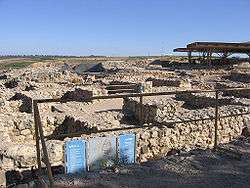
The archaeological remains suggest that after its destruction, the city of Hazor was rebuilt as a minor village within "the territory of Naphtali" (Joshua 19:36).[26] According to the Books of Kings, the town, along with Megiddo, and Gezer, was substantially fortified and expanded by Solomon.[27] Like Megiddo and Gezer, the remains at Hazor show that during the Early Iron Age the town gained a highly distinctive six chambered gate, as well as a characteristic style to its administration buildings; archaeologists determined that these constructions at Hazor were built by the same leadership as those at Megiddo and Gezer.[22] Some archaeologists conclude that they were constructed in the tenth century by King Solomon;[28] others date these structures to the early 9th century BC, during the reign of the Omrides.[22]
Yigael Yadin, one of the earliest archaeologists to work on the site, saw certain features as clearly being Omride; Megiddo, Gezer, and Hazor, all feature deep rock cut pits, from the base of which were rock cut tunnels leading to a well that reached the water table, as water-supply systems, which Yadin attributed to the rule of Ahab; Yadin also attributed to Ahab a citadel, measuring 25 x 21 m, with two-meter thick walls, which was erected in the western part of Hazor. However, Yadin's dating was based on the assumption that the layer connected with the gates and administration buildings were built by Solomon.[22]
Archaeological remains indicate that towards the later half of the 9th century BC, when the king of Israel was Jehu, Hazor fell into the control of Aram Damascus. Some archaeologists suspect that subsequent to this conquest Hazor was rebuilt by Aram, probably as an Aramaean city. When the Assyrians later defeated the Aramaeans, Hazor seemingly returned to Israelite control; Assyrian records indicate that Joash, king of Israel at the time, had paid tribute to Assyria and Israel had become an Assyrian vassal.[22] Subsequently, the town, along with the remainder of the kingdom of Israel, entered a period of great prosperity, particularly during the rule of Jeroboam II. Some archaeologists attribute the later large scale constructions at Hazor, Megiddo, and Gezer, including the rock cut water supply systems, to this era.
Israel's attempted rebellion against Assyrian domination resulted in an invasion by the forces of the Assyrian ruler, Tiglath-Pileser III; the evidence on the ground suggests that hasty attempts were made to reinforce the defenses of Hazor.[22] Despite the defences, in 732 BC Hazor was captured, its population deported,[22][29] and the city was burnt to the ground.[22][30]
See also
- Archaeology of Israel
- Cities of the ancient Near East
- Early Israelite campaigns
- National parks and nature reserves of Israel
References
- Gauthier, Henri (1927). Dictionnaire des Noms Géographiques Contenus dans les Textes Hiéroglyphiques Vol. 4. p. 24.
- Wallis Budge, E. A. (1920). An Egyptian hieroglyphic dictionary: with an index of English words, king list and geological list with indexes, list of hieroglyphic characters, coptic and semitic alphabets, etc. Vol II. John Murray. p. 1021.
- "Scorched Wheat May Provide Answers on the Destruction of Canaanite Tel Hazor - Biblical Archaeology Society". biblicalarchaeology.org. 2012-07-24. Retrieved 2015-09-03.
- John Garstang, History in the Bible, American Journal of Economics and Sociology, vol. 3, no. 3, Essays in Memory of Franz Oppenheimer 1864–1943, pp. 371-385, 1944
- Yadin, Yigael (February 1956). "Excavations at Hazor". The Biblical Archaeologist. 19 (1): 2–11. doi:10.2307/3209263. JSTOR 3209263.
- Yadin, Yigael (May 1957). "Further Light on Biblical Hazor: Results of the Second Season, 1956". The Biblical Archaeologist. 20 (2): 33–47. doi:10.2307/3209148. JSTOR 3209148.
- Yadin, Yigael (May 1958). "The Third Season of Excavation at Hazor, 1957". The Biblical Archaeologist. 21 (2): 30–47. doi:10.2307/3209155. JSTOR 3209155.
- Yadin, Yigael (February 1959). "The Fourth Season of Excavations at Hazor". The Biblical Archaeologist. 22 (1): 2–20. doi:10.2307/3209103. JSTOR 3209103.
- Yigal Yadin, The Fifth Season of Excavations at Hazor 1968–1969, The Biblical Archaeologist, vol. 32, no. 3, pp. 50-71, 1968
- "Image: a.a.0203.430.1.9.jpg, (245 × 163 px)". haaretz.co.il. Retrieved 2015-09-03.
- 'Hammurabi-like' cuneiform discovered at Tel Hazor, Haaretz
- Reply To Robert Morey's Moon-God Allah Myth: A Look At The Archaeological Evidence, in mquran.org, 22 November 2006
- Mohd Elfie Nieshaem Juferi, "The Mysterious Statue at Hazor: The “Allah” of the Muslims?, in Bismika Allahuma, October 15, 2005
- Sharon Zuckerman (June 2013), Hazor in the Early Bronze Age, Near Eastern Archaeology, Vol 76, No. 2, pp. 68–73
- Shlomit Bechar (June 2013). "Tel Hazor: A Key Site of the Intermediate Bronze Age". Near Eastern Archaeology. 76 (2): 73–75. doi:10.5615/neareastarch.76.2.0073. JSTOR 10.5615/neareastarch.76.2.0073.
- Abraham Malamat, "Silver, Gold, and Precious Stones from Hazor" in a New Mari Document, The Biblical Archaeologist, vol. 46, no. 3, pp. 169-174, (Summer, 1983)
- Joshua 11:1-5, 11:10-13
- Judges 4
- Peake's commentary on the Bible
- Jewish Encyclopedia, Book of Joshua, Book of Judges
- Jewish Encyclopedia, Jabin
- Israel Finkelstein, The Bible Unearthed
- "The Hazor Excavations Project". unixware.mscc.huji.ac.il. Retrieved 2015-09-03.
- A 3,400-year-old mystery: Who burned the palace of Canaanite Hatzor, Haaretz
- "Tel Hazor Israelite City Gate". Madain Project. Retrieved 10 May 2020.
- Negev, Avraham/Gibson, Shimon, Archaeological Encyclopedia of the Holy Land, New York/London 2001, p.220, ISBN 0-8264-1316-1 (English)
- 1 Kings 9:15
- William G. Dever, What Did the Biblical Writers Know, and when Did They Know It? 2002 p.43
- 2 Kings 15:29
- However, the correlation between the destruction of Stratum V with Tiglath-Pileser III's campaign has been challenged; cf. P. James, "The Alleged 'Anchor Point' of 732 BC for the Destruction of Hazor V", AntOr 6 (2008).
Further reading
- Ruhama Bonfil and Anabel Zarzecki-Peleg, The Palace in the Upper City of Hazor as an Expression of a Syrian Architectural Paradigm, Bulletin of the American Schools of Oriental Research, no. 348, pp. 25–47, Nov 2007
- Ruhama Bonfil, Coming before the King—A Ceremonial Basin in Hazor’s Throne Room. Eretz-Israel 30 (Amnon Ben-Tor Volume): 59–72 (Hebrew), 145*–46* (English summary).
- Zarzecki-Peleg, A and Bonfil, R. (2011) A Syrian City-State in Mitanni’s Orbit? Ugarit-Forschungen 43: 537-567
- Yadin Yigael and Et Al. Yadin, Hazor I : An Account of the First Season of Excavations, 1955, Magnes Press, 1958
- Yadin Yigael, Hazor II: An Account of the Second Season of Excavations, 1956 [James A. De Rothschild Expedition at Hazor], Oxford University Press, 1961, ISBN 0-19-647165-6
- Yadin Yigael, Hazor III - IV. An Account of the Third and Fourth Seasons of Excavations, 1957–1958. The James A. De Rothschild Expedition at Hazor, Biblical Archaeology Society, 1989, ISBN 965-221-008-0
- A. Ben Tor and Robert Bonfil, Hazor: v. 5: The James A De Rothschild Expedition at Hazor (Ancient synagogues studies), Israel Exploration Society, 1997, ISBN 965-221-003-X
- Ben-Tor, Amnon, Doron Ben-Ami, and Debora Sandhaus, Hazor VI. The 1990 - 2009 Excavations. The Iron Age.,Israel Exploration Society: Institute of Archaeology, Hebrew University of Jerusalem, 2012
- Ben-Tor, Amnon, Sharon Zuckerman, Shlomit Bechar, and Débora Sandhaus, HAZOR VII. The 1990-2012 Excavations. The Bronze Age, ed. Tsipi Kuper-Blau. Hebrew University of Jerusalem, Israel Exploration Society, 2017
- Yadin Yigael, Hazor (Schweich Lectures on Biblical Archaeology), British Academy, 1972, ISBN 0-19-725925-1
- Yadin Yigael, Hazor: Rediscovery of a Great Citadel of the Bible, Littlehampton, 1975, ISBN 0-297-76845-X
- Schulamit Geva, Hazor, Israel (British Archaeological Reports (BAR)), BAR, 1989, ISBN 0-86054-689-6
- S. Zuckerman, Where is the Archive of Hazor Buried?, Biblical Archaeology Review, vol. 32, pp. 28–37, 2006
- S. Zuckerman, "'...Slaying oxen and Killing Sheep, Eating Flesh and Drinking Wine...': Feasting in Late Bronze Age Hazor," Palestine Exploration Quarterly, 139,3 (2007), 186-204.
External links
| Wikimedia Commons has media related to Hatzor. |
- The Hazor Excavations Project - Hebrew University of Jerusalem
- "Yadin photographs & footage of the excavations"
- The Hazor Excavation Reports - Hebrew University of Jerusalem
- UNESCO World Heritage site for Hazor